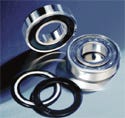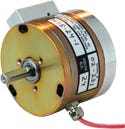Wireless data collected directly from patients during normal physical activities could enable the development of better knee implants
March 6, 2008
Originally Published MPMN March 2008
SPOTLIGHT
Precision Motion Control
Ultraminiature ball screw
|
A company has introduced what it claims is the world’s smallest commercially available stainless-steel ball screw. Featuring a diameter measuring only 3 mm, the product comes in a choice of 1- or 0.5-mm pitch. The supplier also offers a range of miniature stainless-steel screws with diameters ranging from that of the ultraminiature screw up to 16 mm. Offered either with or without preloading, the screws are outfitted with one of four types of ball nuts. Applications include surgical robots and fluid-dispensing pumps, among others.
Steinmeyer Inc., Burlington, MA
www.steinmeyer.com
Lubricant bearings
|
Employed in such medical applications as infusion pumps, a line of sealed lubricant bearings is available with inside diameters ranging from 1⁄8 to 1 in. Preinstalled oil-filled polymers lubricate the bearings with a film or oil. Because the oil-filled polymers contain approximately twice the amount of oil found in most greases, excess oil is available for lubrication, according to the company. As a result, the product is suited for harsh environments or equipment that requires frequent cleaning. Stainless- and chrome-steel construction is available for most sizes.
Sapporo Precision Bearings USA (SPB-USA), Sarasota, FL
www.spb-usa.com
Hysteresis brakes
|
Engineered with the manufacturer’s patented Cog-Buster to automatically smooth braking torque, hysteresis brakes can be used in the winding process employed in the manufacture of stents and wire-reinforced medical tubing. Precision wire tension can easily be maintained, even on open-loop systems, according to the company. Torque is smooth—even near zero rpm—owing to the production of frictionless torque via internal magnetic fields, rather than contact between parts. Units are available with torques from 0–11 to 250 oz-in. and heat dissipation to 110 W.
Placid Industries Inc., Lake Placid, NY
www.placidindustries.com
Self-aligning bearings
|
A coefficient of friction as low as 0.001 enables users of a line of bearings to employ smaller and more cost-effective motors, belts, gears, and ball screws than those used with high-friction bearings, according to the manufacturer. Offered in 16-, 20-, 25-, 30-, 40-, and 50-mm versions, the Super Ball Bushing bearings feature a self-aligning capability of up to 0.5° that automatically compensates for inaccuracies in base flatness or carriage machining. Acceleration rates up to 150 m/sec2 and steady-state travel speeds 3 m/sec can be achieved without the derating factors commonly required with linear guides. Adjustable open and closed configurations are offered. Lightweight wear-resistant polymer retainers and outer sleeves reduce inertia and noise. The company maintains that, when combined with its 60 Case shafting, the bearings can withstand three times the load of conventional bearings and can last 27 times longer.
Danaher Motion, Wood Dale, IL
www.danahermotion.com
Optical encoder
|
A company’s optical encoder features a 1.2-in. OD, an overall height just exceeding 1 in., and the stability of a bearing encoder design. Configured to potentially replace a modular encoder in an application, the QR12 offers increased versatility and an improved feedback solution, as well as performance upgrades, according to the supplier. It further claims that a flexible member enables greater tail-shaft run-out than can be tolerated by modular encoders; it also provides 30° of rotation for commutation timing. Outputs consist of a quadrature with index pulse and three-phase commutation.
Quantum Devices Inc., Barneveld, WI
www.quantumdev.com
Roller pinion system
|
Enabling engineers to incorporate accurate linear and rotary motion control functions with zero backlash and speeds up to 11 m/sec, a roller pinion system (RPS) can be used in such large medical equipment as MRI, PET, and tomography units. In applications requiring high speed, accuracy, and low noise, the RPS can be used in lieu of typical rack and pinions, linear motors, spur gears, chain and belt drives, and ball screws. The system consists of a drive pinion with bearing-supported rollers that move along the face of the rack or gear-tooth profile, producing low noise, vibration, and wear.
Nexen Group Inc., Vadnais Heights, MN
www.nexengroup.com
Piezoelectric actuators
|
Designed for applications requiring a small footprint, ultracompact piezoelectric actuators are suited for numerous motion control applications, including miniature valves, optical switching and scanning, and nanopositioning and nanoprobing. The flexure-guided components enable backlash- and friction-free motion. Measuring 8 × 10 × 17 mm, the FPA-80E model features a stainless-steel construction that mechanically amplifies the motion of the internal piezoelectric ceramic, yielding 80 µm of displacement range. Providing 180 µm of displacement range, the FPA-180E is offered in a titanium package measuring less than 8 × 9 × 26 mm.
Dynamic Structures and Materials LLC, Franklin, TN
www.dynamic-structures.com
Copyright ©2008 Medical Product Manufacturing News
You May Also Like









